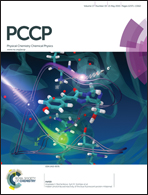Genericity of confined chemical garden patterns with regard to changes in the reactants
Abstract
The growth of chemical gardens is studied experimentally in a horizontal confined geometry when a solution of metallic salt is injected into an alkaline solution at a fixed flow rate. Various precipitate patterns are observed—spirals, flowers, worms or filaments—depending on the reactant concentrations. In order to determine the relative importance of the chemical nature of the reactants and physical processes in the pattern selection, we compare the structures obtained by performing the same experiment using different pairs of reactants of varying concentrations with cations of calcium, cobalt, copper, and nickel, and anions of silicate and carbonate. We show that although the transition zones between different patterns are not sharply defined, the morphological phase diagrams are similar in the various cases. We deduce that the nature of the chemical reactants is not a key factor for the pattern selection in the confined chemical gardens studied here and that the observed morphologies are generic patterns for precipitates possessing a given level of cohesiveness when grown under certain flow conditions.



 Please wait while we load your content...
Please wait while we load your content...